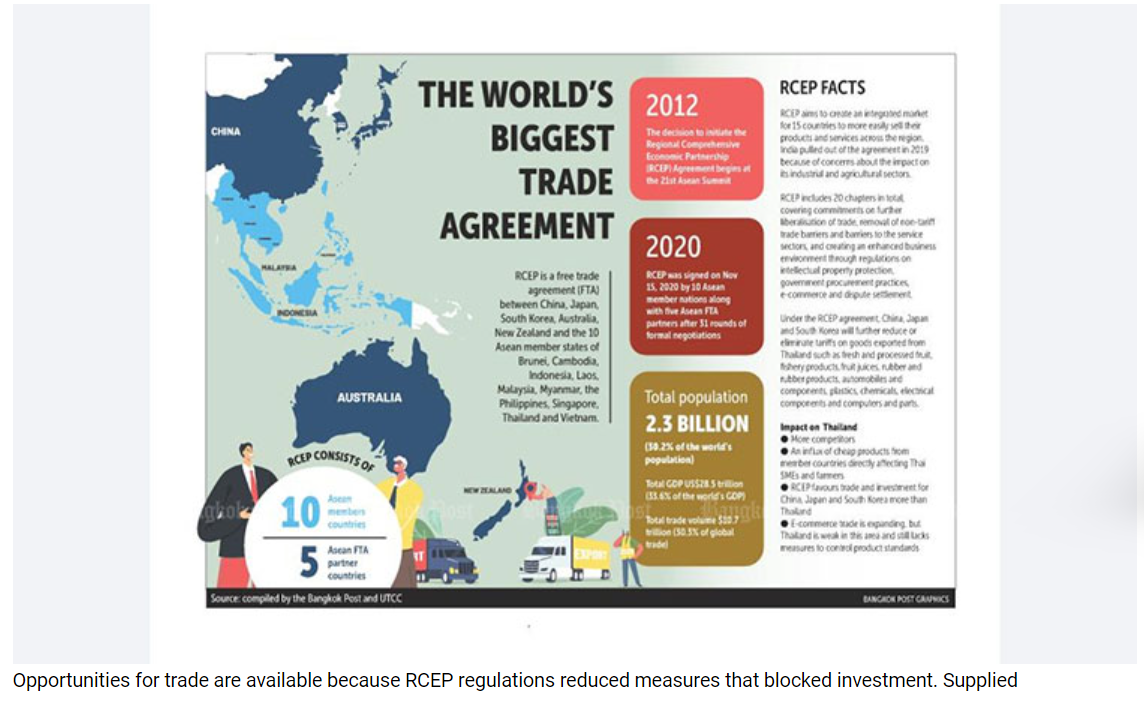As RCEP kicks off, China mulls Cambodia hub for agri and industrial products
Cambodia’s high-quality agricultural products such as rice, bananas, mangoes, fragrant coconuts and cashews shall be exported to Japan, South Korea, Singapore, etc., which will effectively promote enterprises to improve efficiency and sustainable development
Bangkok Post – After much deliberation, the Regional Comprehensive Economic Partnership (RCEP) trade pact came into effect from Jan 1, 2022. The pact was signed on Nov 15, 2020, by the 10 Asean member countries along with five Asean free trade agreement (FTA) partners. At least six members of Asean and three non-Asean nations then ratified the agreement.
RCEP is the world’s biggest FTA measured by GDP, larger than the Comprehensive and Progressive Agreement for Trans-Pacific Partnership, the EU, the Mercosur trade bloc in South America, and the recent US-Mexico-Canada FTA. RCEP is the first multilateral agreement to include China, and the first FTA between China and Japan as well as Japan and South Korea.
RCEP trade volumes tallied over $10.7 trillion, or 30.3% of global trade, in 2020.
Cambodia’s rice export to China alone surpassed 300,000 tons for the first time in 2021, marking another historic milestone in the rice sector between the two countries, according to a report from the China Certification & Inspection Group (CCIC)’s Cambodia branch published last week.
Similarly, Cambodia’s high-quality agricultural products such as rice, bananas, mangoes, fragrant coconuts, and cashews can also be exported to Japan, South Korea, Singapore, etc., which will effectively promote enterprises to improve efficiency and sustainable development.
The RCEP is designed to remove tariffs on 91% of goods, and standardise rules on investment, intellectual property and e-commerce among other trade practices. It aims to create an integrated market with 15 countries, making it easier for products and services from each of these countries to be available across this region.
China is expected to use Vientiane as a distribution and trading hub for agricultural and industrial products to Cambodia, Laos, Myanmar, Vietnam and Thailand, fueled by the railway.
Thailand’s Commerce Ministry estimated Thailand has 39,366 goods that would benefit from the duty reduction (South Korea has 11,104 items, Japan 8,216 items, China 7,491 items, New Zealand 6,866 items, and Australia 5,689 items). Thailand has 29,891 goods that should enjoy zero tariffs immediately after the pact’s implementation.
Benefits touted
Trade Negotiations Department director-general Auramon Supthaweethum said the obvious benefits from the pact for Thailand are exports, mostly related to a pledge from South Korea, Japan and China to reduce or abolish customs tariff collection on additional Thai shipments on top of those already offered under FTAs.
Opportunities for trade in services and investment are available because RCEP regulations have reduced or eliminated measures that blocked investment in the service and non-service sectors.
SME impact
Aat Pisanwanich, director of the Center for International Trade Studies at the University of the Thai Chamber of Commerce, warned that once RCEP becomes effective, Thailand as well as Cambodia, are likely to be flooded by cheap products.
“The RCEP study conducted by stakeholders did not take into account the new high-speed rail line,” said Mr Aat. “Entrepreneurs in border provinces with Laos will receive a heavy direct blow from the Laos-China rail network. They are highly likely to become mere distributors of cheap Chinese products if they fail to adjust their business plan.”
Chaichan Chareonsuk, chairman of the Thai National Shippers’ Council, said Thai entrepreneurs will see stiffer competition from RCEP members, particularly those who sell similar products.


 English
English




